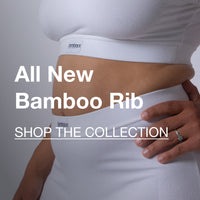French Terry: An Iconic and Enduring History
Leave it to the French to lead the way in textiles, by first developing a fabric (first silk, later cotton) in the 1800s that required pulling looser longer knots of fabric through denser woven bits of cloth to create what we now know as terrycloth. Deriving from the French word “tirer,” a translation that literally is “to pull,” it grew into great mass production as towels. How then did this origination evolve into its sister fabric, French terry?
As this great fabric evolved past the use of terrycloth towels, it switched to a lighter weight, albeit similar material, that involved looping on only one side of the cloth, leaving the loopless side smooth and soft with more stretch than the original version. Early adaptations of French terry joggers and sweats. One of the most prolific uses of French terry fabric in modern-day is the rise (and later reinvention) of the Juicy Couture tracksuit.
When the high-end athleisure wear made its debut in the spring of 2001, everyone took notice of the glitz and glam appeal of what had previously been thought of as a practical type of fabric made primarily for sports warm-ups and casual clothes to wear while performing everyday tasks. J.Lo was spotted in a different color of tracksuit nearly every day and memorialized the style in her “I’m Real” music video in 2001. Much of young Hollywood at the time also embraced the look with celebrities like Paris Hilton, Nicole Richie, and Lindsay Lohan all wearing terry tracksuits with sneakers or flip flops and their designer handbags.
Much like the freedom of expression by wearing the fabric in the late 1800s, fashion was made fun again through the introduction of the iconic Juicy Couture tracksuit, with a follow-up nostalgic nod to the French terry favorite as recently as 2018. Designer Isaac Mizrahi brought life back to the look when he showed a new wave of French terry on the runway of New York Fashion Week in a variety of ways, including everything from pink sequins to plush leopard to sparkly gold brocade. This changes the idea of what’s deemed fashionable, even when using simpler fabrics, by simply saying, hey, this is what works for us.
As the high-end brand of the time began to trickle down with knock-off styles available at department stores worldwide, French terry had an “it” moment, which had gone overlooked and under appreciated for years. Although the discussion around the rise of the expensive tracksuit meant to depict different ideas, as outlined in an article in the New Yorker, the common theme of the style was a bold, in-your-face stance of wearing whatever made you feel comfiest and your most confident.
The “Freedom Fabric” for Women and Queer People
The boom of wearing French terry was embraced by women and queer people who wanted fashion that both allowed for freedom of expression, but maintained the functionality of everyday life that didn’t always call for buttoned-up and restrained styles. It could be argued, especially with the Juicy Couture tracksuit, that the laid-back spirit of French terry fabric is a rebellious affront to those who claim there’s only one way to wear high fashion.
It also drew attention to areas that were previously made invisible, both fashion-wise and culturally speaking. Others could simply make the point that wearing it felt fantastic and that was good enough for it to stick. Either way, fashion has always had its place in history that’s telling of the times. There’s a story behind every great fabric and designer that dates back before even the first piece of clothing is produced. Like with any other art form, fashion always has a purpose it’s trying to convey.
In a special exhibition gallery at the Museum at FIT in New York from 2013 to 2014, a display of over 100 pieces from high-end designers walked viewers through A Queer History of Fashion: From the Closet to the Catwalk. The exhibit explored “modern fashion through the lens of gay and lesbian life and culture” and addressed subjects including “androgyny, dandyism, and transgressive aesthetic styles” that are still apparent and continue to inspire styles of today.
As queer people and women continue to break down barriers of what is acceptable per societal standards, one only needs to take a look back at the trendsetting French for inspiration of how to turn fashion on its head. Since it is meant to be a form of self-expression, it only makes sense that designers over the decades have taken it upon themselves to shock-and-awe the traditional norms with styles that embrace diversity rather than stay boxed into what is considered masculine or feminine.
Like the French have done for so long, designers like Isaac Mizrahi, Alexander McQueen, and Christian Dior, to name a few, have built careers based on beautiful creations regardless of societal parameters, most notably with androgynous style. The blurring of lines between masculinity and femininity gave designers and those who wore the style more freedom to choose based on their mood, inspiration, and personal aesthetic.
Rihanna is a prime example of a woman who bucks trends and dresses for herself. Her styling of Rag & Bone’s French terry maxi dress with complementing Puma sneakers and backwards ball cap in 2015 was her take on street-style fashion where comfort meets chic, a look that would serve as inspiration for her Fenty collection a few years later. Beyonce also relied on the ultra-soft fabric when creating pieces for her Ivy Park activewear brand.
Additionally, French fashion house Balmain uses French terry for its iconic logo sweatshirts, as does former Spice Girl-turned-designer Victoria Beckham. Pop superstars like Ariana Grande and Billie Eilish have created a whole craze over their love for French terry when styling their outfits. Although Ariana goes for knee-high boots and Billie prefers high-top sneakers, each favor the oversized hoodie, which Billie says she wears to protect herself from opinions about her body.
French terry fabric may have had a modest start meant to be accessible to all, without ever having such a spotlight shone on it being an initial thought. However, it has become one of the cornerstones of history that have created a space to fit a greater category of people of all genders, races, and economic statuses without appearing less than for its humble beginnings. It eliminated the notion of being separated into individual boxes where fashion is only attainable by an elite few. French terry is the super soft fabric that says, if you want to be comfortable in the world, this is for you.
The Black with Rainbow Collection Upholds History in a Modern Way
When history shows us that fabrics and fashion hold more weight than they’re often given credit for, it only makes sense for us to incorporate French terry into our beloved Rainbow collection. On the surface, the collection represents the chic, comfortable appeal of loungewear, including everything from cozy hoodies to joggers to crew neck sweatshirts. However, its roots have history woven in from those who paved the way and allowed us to make it our own.
The Black with Rainbow collection fully embraces the comfort of the French terry fabric with specific design elements to keep things cozy. Stretchy ribbed cuffs and deep pockets make the clothing in this collection perfect for everyday wear. The vibrant rainbow design lining the black background shines light onto the pieces that are reflective of the evolution of everything that French terry has stood for in the past. It’s a respectful nod to the history of queer people who have come before and redefined the rules to work for them.
The fashion world at every level has something to say, from the fabrics chosen to the values of the designers to the people who wear them. It’s important to pay homage to those who have created a new narrative and made it as versatile and diverse as it is today. At a time when people were expected to be put-together, dolled up, and modestly covered on a daily basis, French terry gave them an excuse to feel free in their own skin. It’s no surprise that styles have changed over the decades to mirror historical changes as women’s liberation began and civil rights started to take focus after years of repression.
During the in-your-face trends of the late ‘90s and early ‘00s, French terry once again made an appearance to show the world something unexpected and fresh. Through the simplicity of what is essentially a pragmatic fabric, there has been space made for women and queer people, and anyone who has been societally driven to the back in the past. It flipped the script on expectations and generalized roles and let people let loose without being questioned about their choices, fashion or otherwise.
There’s always more than meets the eye in every way we present ourselves. The history of French terry marches on even today in a way that honors its beginnings and how far it’s come in the name of fashion.





